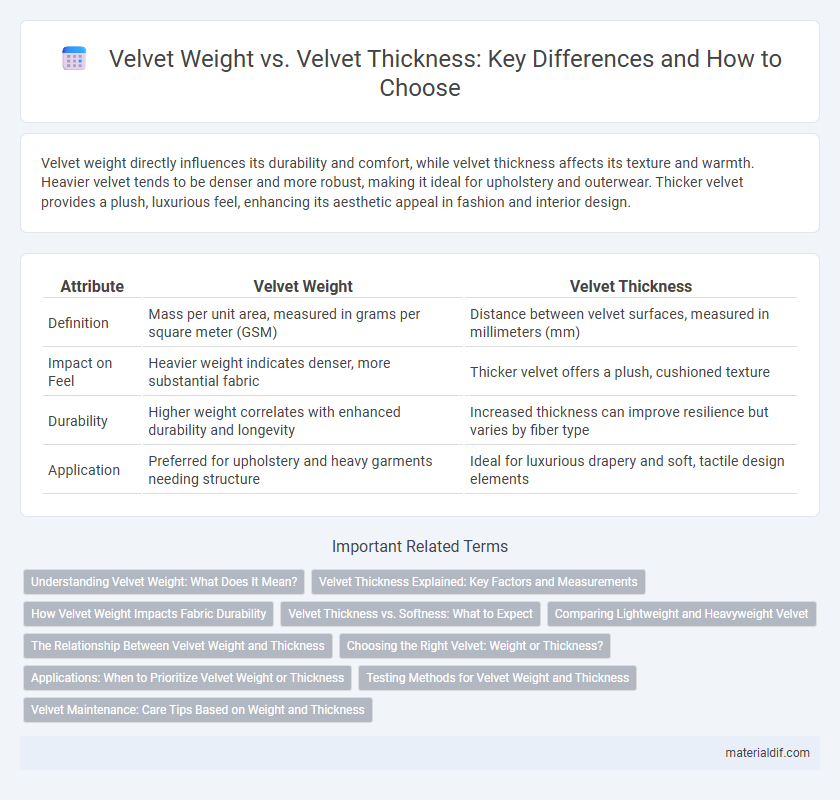Velvet weight directly influences its durability and comfort, while velvet thickness affects its texture and warmth. Heavier velvet tends to be denser and more robust, making it ideal for upholstery and outerwear. Thicker velvet provides a plush, luxurious feel, enhancing its aesthetic appeal in fashion and interior design.
Table of Comparison
| Attribute | Velvet Weight | Velvet Thickness |
|---|---|---|
| Definition | Mass per unit area, measured in grams per square meter (GSM) | Distance between velvet surfaces, measured in millimeters (mm) |
| Impact on Feel | Heavier weight indicates denser, more substantial fabric | Thicker velvet offers a plush, cushioned texture |
| Durability | Higher weight correlates with enhanced durability and longevity | Increased thickness can improve resilience but varies by fiber type |
| Application | Preferred for upholstery and heavy garments needing structure | Ideal for luxurious drapery and soft, tactile design elements |
Understanding Velvet Weight: What Does It Mean?
Velvet weight refers to the density and heaviness of the fabric, measured in grams per square meter (GSM), which directly impacts its durability and suitability for different applications. Thicker velvet often feels more luxurious and plush, but weight provides a more precise indicator of the fabric's substance and performance. Understanding velvet weight helps in selecting the right type for upholstery, fashion, or drapery, balancing texture with practical use.
Velvet Thickness Explained: Key Factors and Measurements
Velvet thickness is a critical parameter influencing the fabric's texture, durability, and luxurious feel, typically measured in millimeters or denier that indicate the pile's depth and density. Key factors affecting velvet thickness include the type of fibers used, the weaving technique, and the pile height, which directly contribute to the fabric's softness and thermal insulation properties. Proper measurement tools such as micrometers or specialized fabric thickness gauges ensure accurate assessment, vital for applications in fashion, upholstery, and interior design where precise velvet dimension impacts both aesthetics and functionality.
How Velvet Weight Impacts Fabric Durability
Velvet weight, measured in grams per square meter (GSM), directly influences fabric durability by determining its density and resilience to wear. Heavier velvet with higher GSM typically exhibits greater longevity and resistance to abrasion, making it ideal for upholstery and high-traffic applications. In contrast, lighter velvet fabrics, although softer and more flexible, may wear out faster under frequent use due to reduced thickness and fiber density.
Velvet Thickness vs. Softness: What to Expect
Velvet thickness directly influences its softness, with thicker velvet fabrics generally offering a more luxurious, plush feel. Thicker velvet enhances tactile comfort and adds depth to the texture, making it ideal for upholstery and cozy garments. While weight often correlates with durability, it is the velvet thickness that primarily determines softness and overall tactile experience.
Comparing Lightweight and Heavyweight Velvet
Lightweight velvet typically ranges from 100 to 150 GSM (grams per square meter), offering a soft, breathable texture ideal for garments requiring fluid drape and comfort. In contrast, heavyweight velvet, often exceeding 250 GSM, provides denser pile and increased durability suitable for upholstery and structured apparel. Comparing velvet weight and thickness highlights the balance between luxury feel and practical functionality, with weight directly influencing the fabric's warmth, texture depth, and longevity.
The Relationship Between Velvet Weight and Thickness
Velvet weight and thickness are closely related yet distinct characteristics that influence the fabric's texture and durability. Heavier velvet typically results from denser fibers or a thicker pile, contributing to a more substantial feel and increased warmth. Understanding the precise balance between velvet weight and pile thickness is essential for selecting upholstery or apparel fabrics that meet specific aesthetic and functional requirements.
Choosing the Right Velvet: Weight or Thickness?
Choosing the right velvet involves understanding the difference between velvet weight and velvet thickness, as weight refers to the fabric's density measured in grams per square meter (GSM), while thickness denotes the physical depth of the pile. Velvet weight impacts durability and drape, making heavier velvet ideal for upholstery and formal garments, whereas thickness influences texture and plushness, crucial for comfort and tactile appeal. Selecting the appropriate velvet requires balancing weight for strength with thickness for softness to match specific design and functional needs.
Applications: When to Prioritize Velvet Weight or Thickness
Velvet weight plays a crucial role in applications requiring durability and drape, making it ideal for upholstery and heavy garments where longevity is essential. Velvet thickness is prioritized in fashion and home decor projects that demand a plush, luxurious feel and visual depth, such as evening wear and decorative pillows. Understanding the balance between velvet weight and thickness ensures optimal performance and aesthetic appeal based on the intended use.
Testing Methods for Velvet Weight and Thickness
Testing methods for velvet weight typically involve precision scales to measure fabric density in grams per square meter (GSM), ensuring consistency across production batches. Thickness assessment employs micrometers or digital thickness gauges that accurately record the pile height and fabric depth crucial for texture evaluation. Combining these techniques provides a comprehensive characterization of velvet quality, impacting durability and comfort.
Velvet Maintenance: Care Tips Based on Weight and Thickness
Velvet maintenance varies significantly depending on its weight and thickness; heavier, thicker velvet requires less frequent cleaning but benefits from gentle brushing to maintain its plush texture. Lighter, thinner velvet demands more delicate handling and spot cleaning to prevent damage and preserve its softness. Proper storage in a cool, dry place away from direct sunlight helps prevent discoloration and fabric distortion regardless of velvet type.
Velvet Weight vs Velvet Thickness Infographic

 materialdif.com
materialdif.com